

At the age of eight years, he began to play ping-pong in the parish San Martino in Senigallia. He and his twin brother Giovanni were invincible when they played doubles as a team. Enzo, like all the other kids, played soccer, volleyball, swam and roller-skated. He even reached the fourth place in the national skating championships.
The Dream
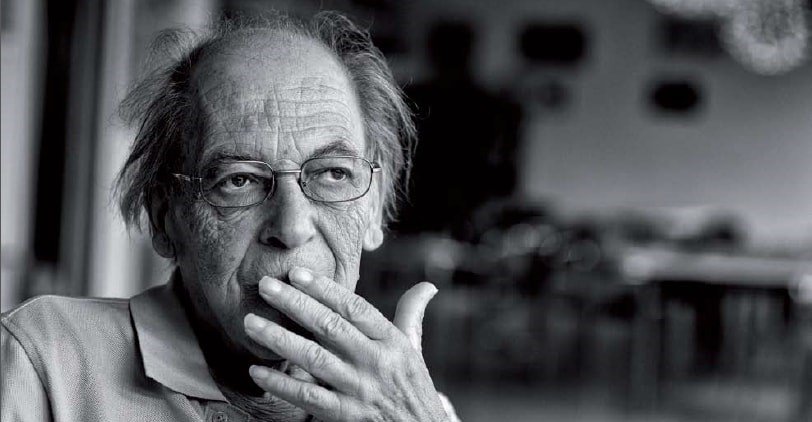 As he grew older, he dedicated himself to ping-pong until he reached the second league. He was fascinated by the musicality of the rhythm and the beauty of the gestures. He noticed that there were different ways of playing, so he quit participating in competitive activities and started to teach. He was followed by three students; one of whom, Domenico Ubaldi, was going to be the president of the society. The first Italian championship titles came, one after another. Enzo became friends with Filippo Dragotto, the federal president. On the occasion of the centenary of the unification of Italy, two of Pettinelli´s students were invited to the international championships in Torino ´61.
As he grew older, he dedicated himself to ping-pong until he reached the second league. He was fascinated by the musicality of the rhythm and the beauty of the gestures. He noticed that there were different ways of playing, so he quit participating in competitive activities and started to teach. He was followed by three students; one of whom, Domenico Ubaldi, was going to be the president of the society. The first Italian championship titles came, one after another. Enzo became friends with Filippo Dragotto, the federal president. On the occasion of the centenary of the unification of Italy, two of Pettinelli´s students were invited to the international championships in Torino ´61.
The four Hearts
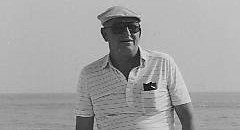 The priest of the San Martino, Father Giuliano Grassi, let the courtyard be covered in order to create a gym. A representative of sports articles, Nero Ravini, coincidentally passed by the gym. He was so moved seeing all those children around a single, old table, that he decided to donate three additional tables. The game based on its esthetic beauty and musicality led to fresh motivation and in near future to more championship titles. In the 60´s, a brotherly friendship was born between Enzo Pettinelli and the federal president Filippo Dragotto. Afterwards he became the voluntary president of the TT Senigallia for the attention, the proximity and esteem for the society. One of the sponsors, Otello Montesi, provided economic aid without asking anything in return.
The priest of the San Martino, Father Giuliano Grassi, let the courtyard be covered in order to create a gym. A representative of sports articles, Nero Ravini, coincidentally passed by the gym. He was so moved seeing all those children around a single, old table, that he decided to donate three additional tables. The game based on its esthetic beauty and musicality led to fresh motivation and in near future to more championship titles. In the 60´s, a brotherly friendship was born between Enzo Pettinelli and the federal president Filippo Dragotto. Afterwards he became the voluntary president of the TT Senigallia for the attention, the proximity and esteem for the society. One of the sponsors, Otello Montesi, provided economic aid without asking anything in return.
The early 70´s
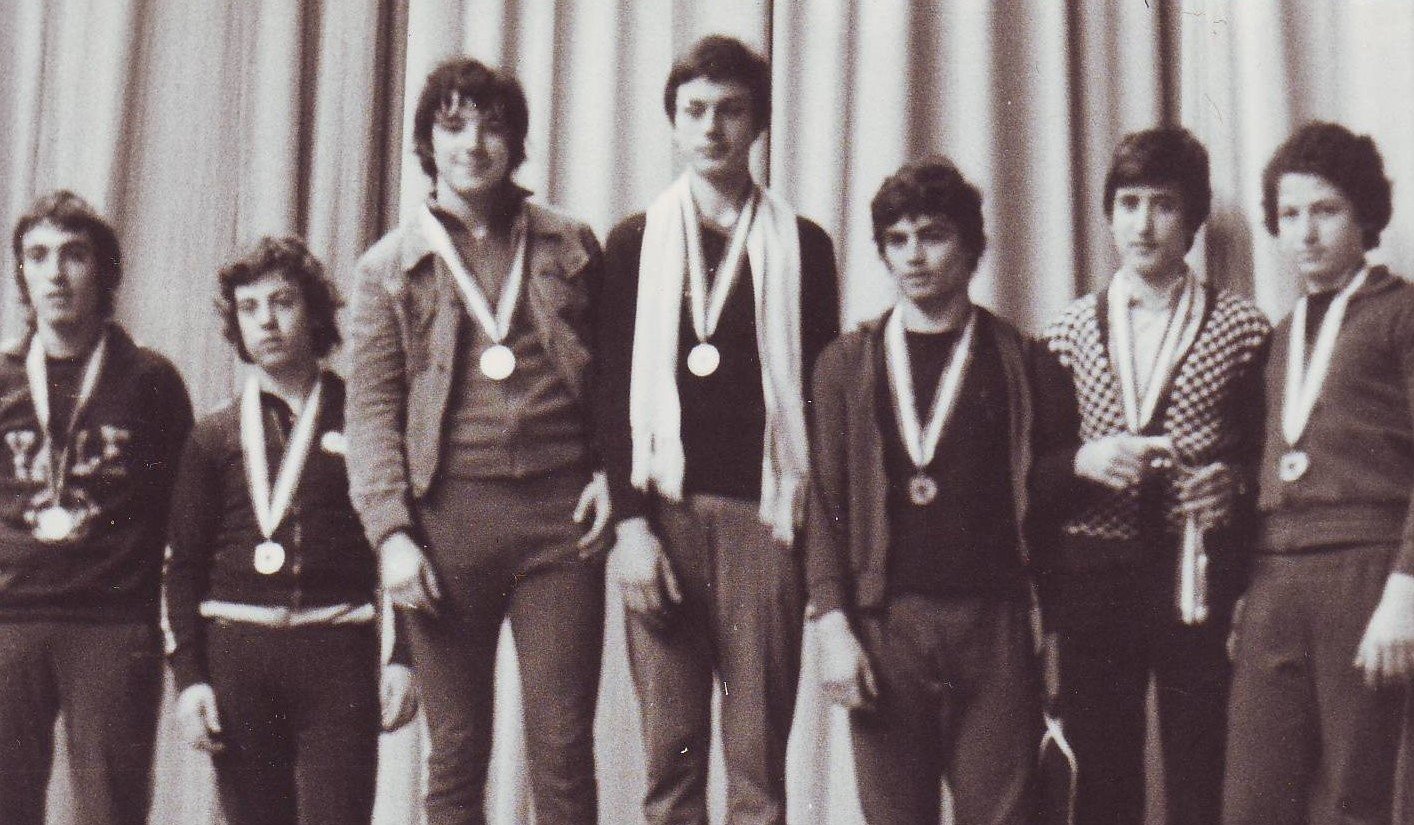 In the late 60´s, Pettinelli decided in collaboration with Rocchetti, Ubaldi, Ceresi and Simoncioni Luigi the technical lines of the school. They suspended the national activities in order to study new techniques. They participated in the first national tournament in Rome. The technical progress was immediately noticeable. Costantini and Apolloni were on the first and second place in the amateur category. After that, a series of placings for the whole team followed. While Simoncioni and Costantini participated in more tournaments, the other players from Senigallia started to connect with Giontelli, Panerai, Sardelli and others. After that, the best students from Italy came to Senigallia to study new techniques.
In the late 60´s, Pettinelli decided in collaboration with Rocchetti, Ubaldi, Ceresi and Simoncioni Luigi the technical lines of the school. They suspended the national activities in order to study new techniques. They participated in the first national tournament in Rome. The technical progress was immediately noticeable. Costantini and Apolloni were on the first and second place in the amateur category. After that, a series of placings for the whole team followed. While Simoncioni and Costantini participated in more tournaments, the other players from Senigallia started to connect with Giontelli, Panerai, Sardelli and others. After that, the best students from Italy came to Senigallia to study new techniques.
The Game in Italy Would Never Be the Same
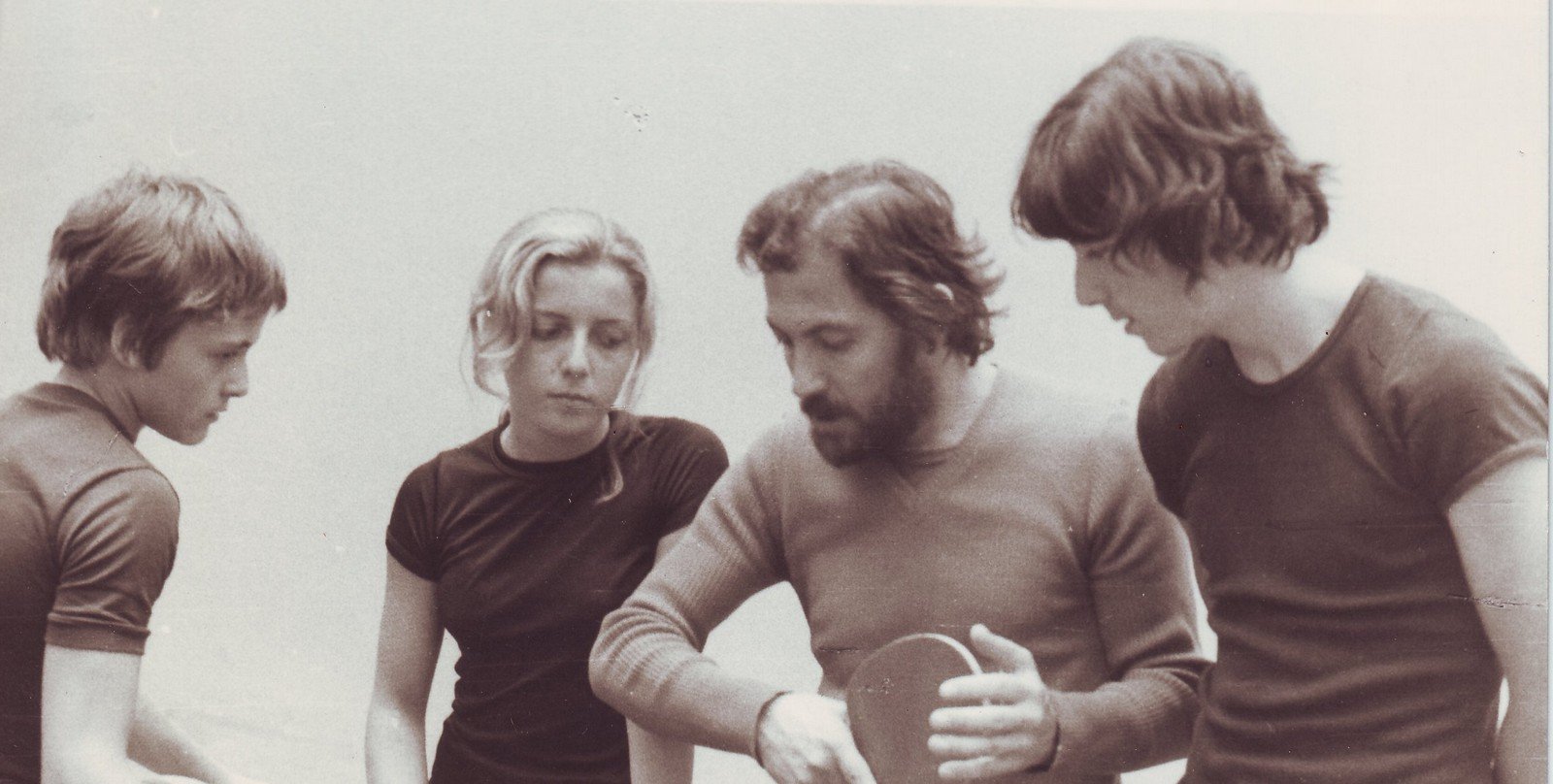 The players started to move from the center of the table slightly to the left, the gestures became shorter and quicker. The legs were more bent, they studied the crossed step to go to the right. After a few years, the second category, that was considered the elephant cemetery, became younger, while the older members slowly disappeared. Other players, older but with a well-developed technique, preferred to invite Costantini to their own society; rather as a preparation to confront him, then to actually learn from it. But the change had already begun. All players by now had moved from the central position to the left. A new game was created, more dynamic with modified gestures which caused the forehand to be used predominantly. And since also the legs were of more importance, vital importance, from that moment on it was impossible to play without a proper physical preparation. Di Rosa had the task to take care of the players´ preparation, later also in the nationals.
The players started to move from the center of the table slightly to the left, the gestures became shorter and quicker. The legs were more bent, they studied the crossed step to go to the right. After a few years, the second category, that was considered the elephant cemetery, became younger, while the older members slowly disappeared. Other players, older but with a well-developed technique, preferred to invite Costantini to their own society; rather as a preparation to confront him, then to actually learn from it. But the change had already begun. All players by now had moved from the central position to the left. A new game was created, more dynamic with modified gestures which caused the forehand to be used predominantly. And since also the legs were of more importance, vital importance, from that moment on it was impossible to play without a proper physical preparation. Di Rosa had the task to take care of the players´ preparation, later also in the nationals.
European Championships in Zagabria
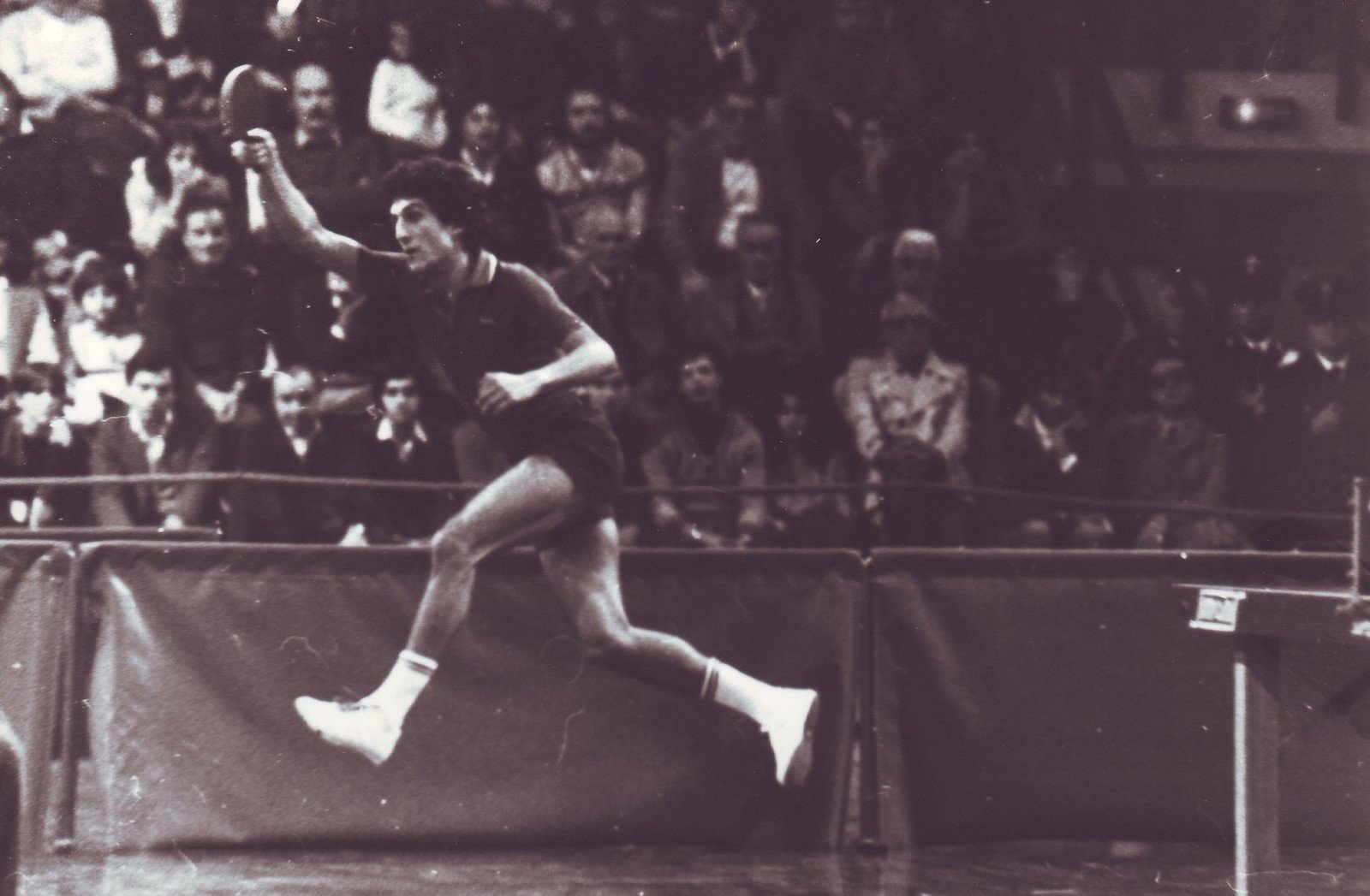 In 1975 Pettinelli, the only one responsible for the nationals and the Italian school, organized the first gathering for the juvenile national championships in Senigallia. The players were accommodated with athletes and responsible persons from Senigallia. Convoked to the European championships were: Giontella, Bisi, Sardelli, Panerai, Cardinali, Saporetti, Costantini and Appolloni. As sparring-partners: the brothers Pesaresi, Campus, Simoncioni, Audisio etc. Then the European championships in Zagabria. The results were historic. It was Bisi Giovanni who brought the European championship title to Italy. Pettinelli followed him turn after turn until he reached the title. It was kept in mind how well Giovanni had grown technically in the family-like atmosphere. After this also Pesaresi and Campus were convoked to the European championships.
In 1975 Pettinelli, the only one responsible for the nationals and the Italian school, organized the first gathering for the juvenile national championships in Senigallia. The players were accommodated with athletes and responsible persons from Senigallia. Convoked to the European championships were: Giontella, Bisi, Sardelli, Panerai, Cardinali, Saporetti, Costantini and Appolloni. As sparring-partners: the brothers Pesaresi, Campus, Simoncioni, Audisio etc. Then the European championships in Zagabria. The results were historic. It was Bisi Giovanni who brought the European championship title to Italy. Pettinelli followed him turn after turn until he reached the title. It was kept in mind how well Giovanni had grown technically in the family-like atmosphere. After this also Pesaresi and Campus were convoked to the European championships.
The first Achievements
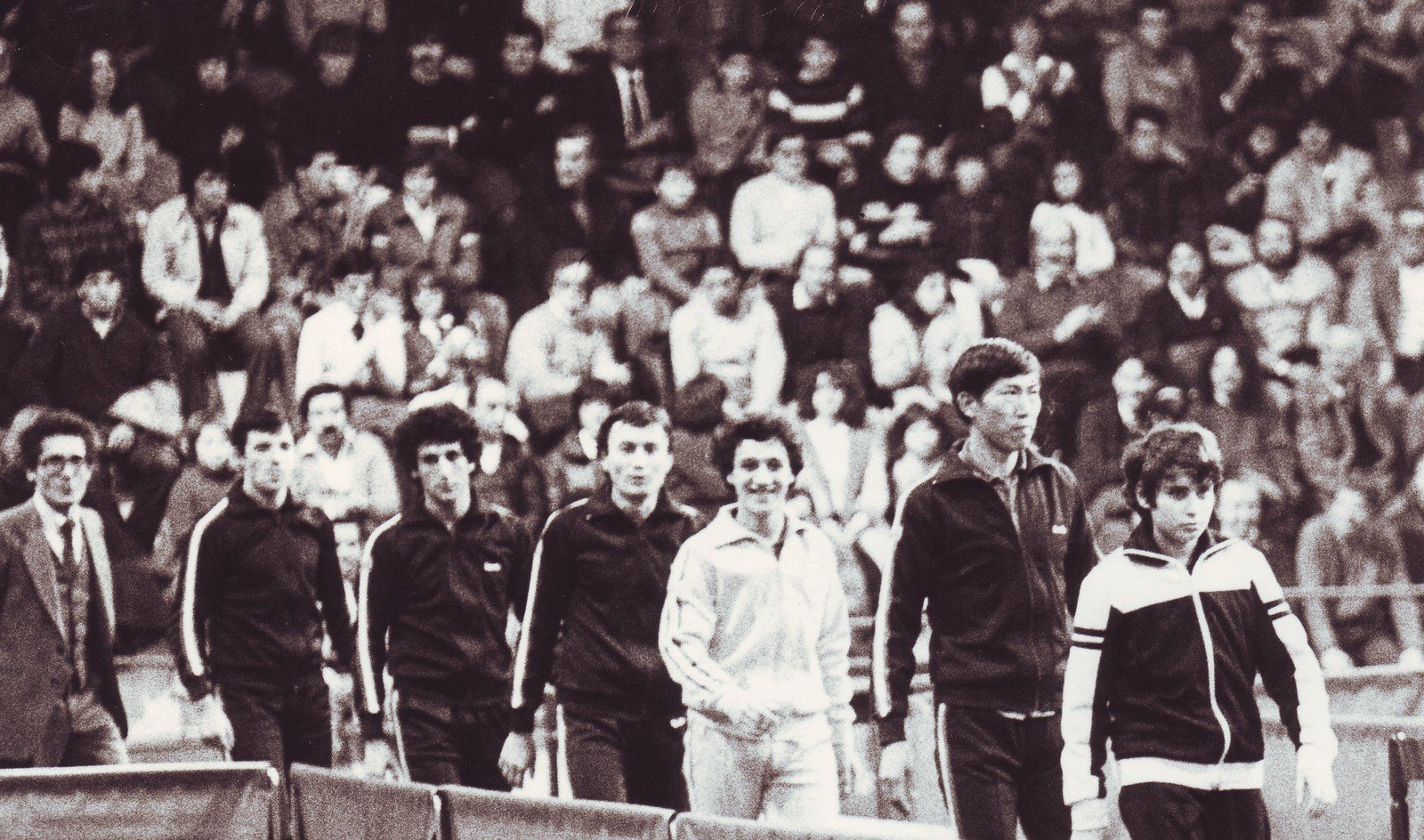 The results, that brought the society to the first place of Italy, arrived. The school, which was already open, got opened further and players from the whole country came. Including opponents that played or had competed against the societies´ players. For a few years, the preparations for the juvenile nationals were held at the Tennistavolo by Italian coaches only. Pettinelli, at that time national consultant, started a new technical course linked to the Italian ping-pong. In that period of time, all of the national and regional tournaments took place. All the changes began within the society of Senigallia, like the need of growth, which satisfied all the member societies. During this historical period, Senigallia won various gold medals at the youth-games and at the national tournaments for the elementary and middle schools, and another gold medal for the middle school with the republic of San Marino which relied on Pettinelli´s school for three years. Pettinelli was going to be national coach, not only of Italy but also of San Marino, for another few times. And If it wasn´t already enough he was an honorary member of the republic of Malta for the lent collaboration.
The results, that brought the society to the first place of Italy, arrived. The school, which was already open, got opened further and players from the whole country came. Including opponents that played or had competed against the societies´ players. For a few years, the preparations for the juvenile nationals were held at the Tennistavolo by Italian coaches only. Pettinelli, at that time national consultant, started a new technical course linked to the Italian ping-pong. In that period of time, all of the national and regional tournaments took place. All the changes began within the society of Senigallia, like the need of growth, which satisfied all the member societies. During this historical period, Senigallia won various gold medals at the youth-games and at the national tournaments for the elementary and middle schools, and another gold medal for the middle school with the republic of San Marino which relied on Pettinelli´s school for three years. Pettinelli was going to be national coach, not only of Italy but also of San Marino, for another few times. And If it wasn´t already enough he was an honorary member of the republic of Malta for the lent collaboration.
The Achievements continued
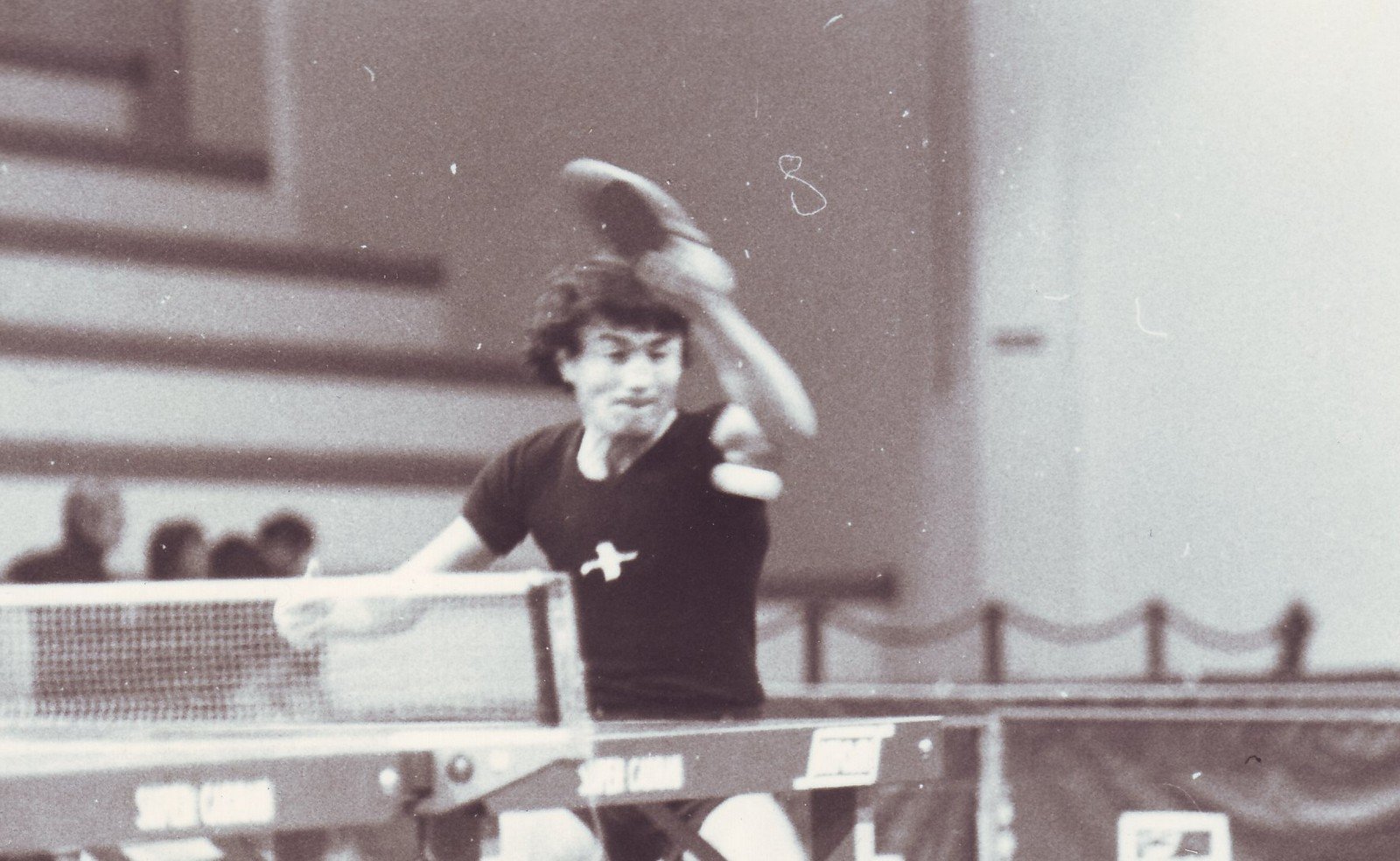 Manoni returned from Milan to his native city. He left his school in Milan with the national ranking N°8, having participated in the European championships in Novi Sad in 1974. After a couple of years, amongst training sessions and military service, he reached important goals: He was going to be finalist at the Italian championships with Costantini in 1978 beating Bisi Giovanni in the quarterfinal and Stefano Bosi in the semifinal. He won the international tournament in Bordighera in 1977 against Costantini. He participated in the European championships in 1978 in Duisburg and in 1980 in Bern. After this, he was amongst the first four in the Italian championships several times, and for various years he remained fifth in the national ranking. He was a point of strength that was going to bring the T.T. Senigallia to victory in two championship titles and the Italy Cup. Also, a first category of Senigallia, for reasons of work, had to move to Milan. In that case, after a year they had to resign to the second category, but returned to the first when they came back.
Manoni returned from Milan to his native city. He left his school in Milan with the national ranking N°8, having participated in the European championships in Novi Sad in 1974. After a couple of years, amongst training sessions and military service, he reached important goals: He was going to be finalist at the Italian championships with Costantini in 1978 beating Bisi Giovanni in the quarterfinal and Stefano Bosi in the semifinal. He won the international tournament in Bordighera in 1977 against Costantini. He participated in the European championships in 1978 in Duisburg and in 1980 in Bern. After this, he was amongst the first four in the Italian championships several times, and for various years he remained fifth in the national ranking. He was a point of strength that was going to bring the T.T. Senigallia to victory in two championship titles and the Italy Cup. Also, a first category of Senigallia, for reasons of work, had to move to Milan. In that case, after a year they had to resign to the second category, but returned to the first when they came back.
A Thought extracted from the Book “La città del ping-pong”
Shortly before the 80´s, a new period was traced; from pureness to brutalization of their sport. The arrival of the economical wellness hit all the social disciplines and movements in Italy. Everything became monetized. Even to create a society, to justify the sponsors, robbed players of the school. Players had to improvise as coaches. They filled a basket with balls and threw thousands of them at the students. Without any method, without heart. It was a Chinese technique, a small part of that school that became a universal, unique, simple and illusory method. That way the brutalization spread like a river that flooded the dam and the nearby territory. Talents and players of good quality moved without technique, the gestures became shorter, the legs moved without order; all of that created physical damage. Some left the society, some threw away their own identities. Unfortunately, this method is still spread nowadays.
The Activities at the Olympic Center Resumed
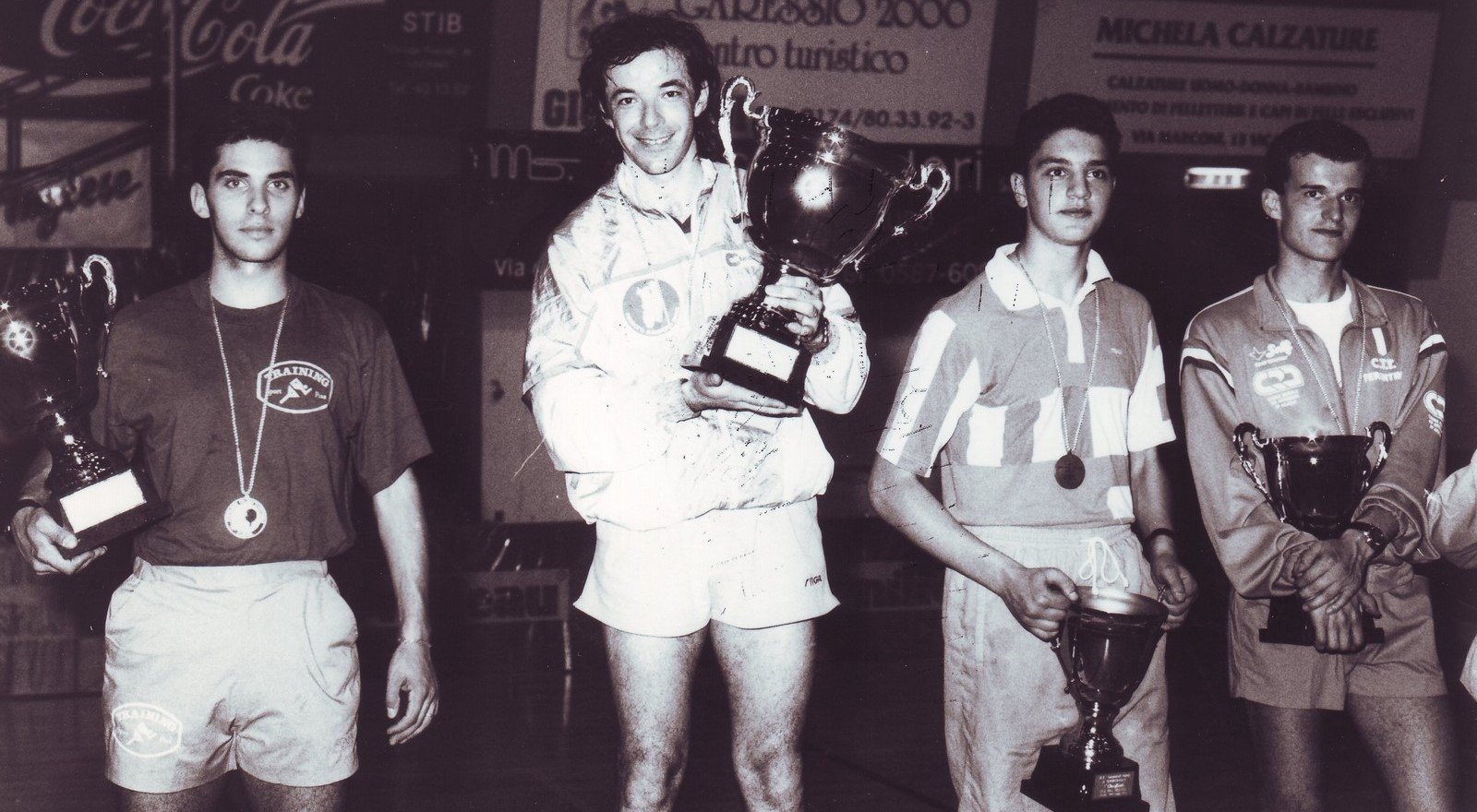 The first Olympic center in Senigallia was opened. Pettinelli designed it and followed the operations. The community of Senigallia and the CONI took care of the financing. After a while also the federation contributed their part. In 1986 the CONI granted the first award for the best realization of a sports facility. They resumed the activities at their new accommodation. In the meanwhile, three factors emerged. The society loses a sponsor, the trend to use a certain type of glue “colla fresca” for the rubbers of the racquets came up and the cultural detachment for some players.
The first Olympic center in Senigallia was opened. Pettinelli designed it and followed the operations. The community of Senigallia and the CONI took care of the financing. After a while also the federation contributed their part. In 1986 the CONI granted the first award for the best realization of a sports facility. They resumed the activities at their new accommodation. In the meanwhile, three factors emerged. The society loses a sponsor, the trend to use a certain type of glue “colla fresca” for the rubbers of the racquets came up and the cultural detachment for some players.
Loss of the Sponsor
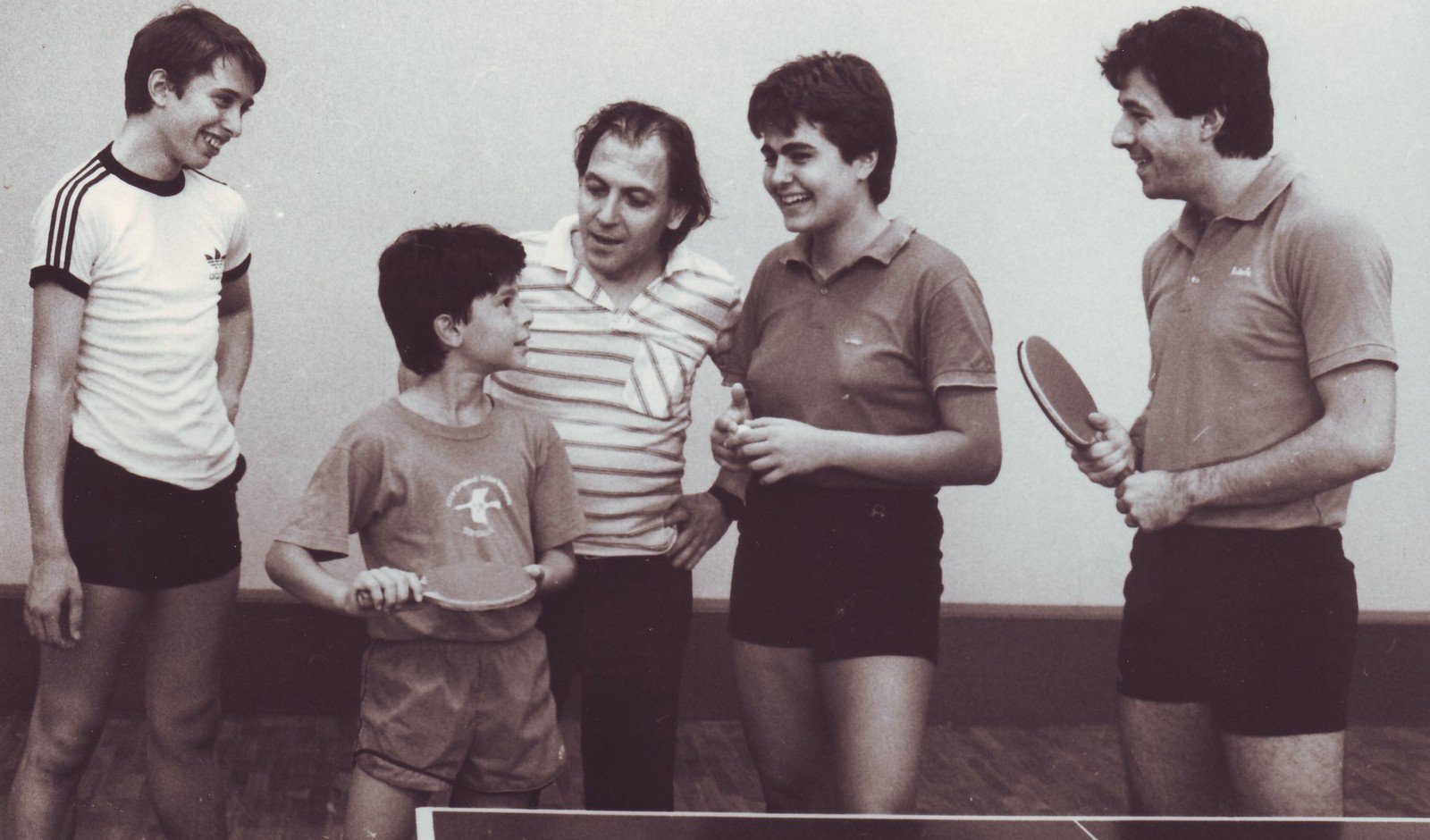 After the society had lost their sponsor, Pettinelli noticed that many of the players decided to play with other clubs. Costantini stayed connected to the school as player and collaborator. The others, which by now had left the national league, practiced at the center to maintain their game but lost the technical relation with the school. After this, Girardi, Moroni, Poli and Ricci were convoked to the European championships. Pettinelli was then elected to be a national consultant, being responsible for the technical sector. He introduced the days for the agonistic activity. This change was also included in the European juvenile championships. Ascoli, Ricci, Poli and Cossìa moved from their native cities to Senigallia. For the world championships in New Delhi they sent Costantini, Ricci and Moretti. The society provided three of seven players. A record. Costantini constantly was in the national championships for 20 years. He set an appearance record in blue uniform among all the sports. Only Moretti, who collaborated though she played with other societies, remained.
After the society had lost their sponsor, Pettinelli noticed that many of the players decided to play with other clubs. Costantini stayed connected to the school as player and collaborator. The others, which by now had left the national league, practiced at the center to maintain their game but lost the technical relation with the school. After this, Girardi, Moroni, Poli and Ricci were convoked to the European championships. Pettinelli was then elected to be a national consultant, being responsible for the technical sector. He introduced the days for the agonistic activity. This change was also included in the European juvenile championships. Ascoli, Ricci, Poli and Cossìa moved from their native cities to Senigallia. For the world championships in New Delhi they sent Costantini, Ricci and Moretti. The society provided three of seven players. A record. Costantini constantly was in the national championships for 20 years. He set an appearance record in blue uniform among all the sports. Only Moretti, who collaborated though she played with other societies, remained.
Rubbers with Fresh Glue
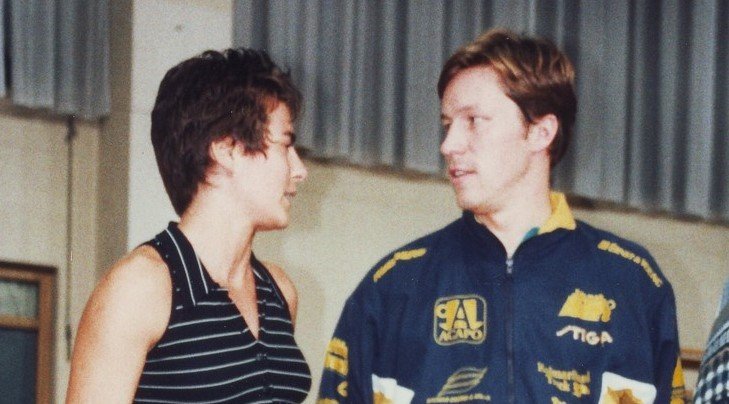 In the meantime, the use of fresh glue prevailed and the technique became less refined. Sensitiveness and precision got lost. The youngsters searched for the solution of their problems on the layers of glue. The technical dialogue was interrupted. Pettinelli suffered a cultural and emotional stop as a consequence of the fresh glue nullifying all the trained technique. Those who had created and matured their game, found more speed and simplicity. The renunciation of precision and sensitiveness were neglected. The new young players were not able to develop a big variety of shots. The racquets were not made for sensitiveness. Therefore, the training became repetitive with less variations and less young talents appeared. The older players on the other hand continued to pursue the careers up to a higher age, e.g. Surbek played until he was 50 years old and Waldner arrived at the 4^th place at the Olympics in Athens.
In the meantime, the use of fresh glue prevailed and the technique became less refined. Sensitiveness and precision got lost. The youngsters searched for the solution of their problems on the layers of glue. The technical dialogue was interrupted. Pettinelli suffered a cultural and emotional stop as a consequence of the fresh glue nullifying all the trained technique. Those who had created and matured their game, found more speed and simplicity. The renunciation of precision and sensitiveness were neglected. The new young players were not able to develop a big variety of shots. The racquets were not made for sensitiveness. Therefore, the training became repetitive with less variations and less young talents appeared. The older players on the other hand continued to pursue the careers up to a higher age, e.g. Surbek played until he was 50 years old and Waldner arrived at the 4^th place at the Olympics in Athens.
The Abolishment of Fresh Glue
The abolishment of the fresh glue caused uncertainty. The only gesture, that by then had lost its speed, revealed the missing technique. They had to restart from the beginning. Those who hadn´t used the fresh glue had a big advantage. Pettinelli found again the pleasure in teaching and continued studying the technique.
Cultural Detachment from Some Players
The cultural detachment first led to individualism, then to the desire of realizing an own society. But, as it happened often, some wanted to be ahead of time. Some prepared players in the ping-pong center stood out. They artificially created friction between them and the original society. But the Tennistavolo Senigallia, after its 50 years of history, had always overcome with ease every obstacle. Matter can be subtracted and disfigured, but the spirit that is the origin of human activity, and the heart which is the engine, can neither be subtracted nor disfigured.
Moments of History
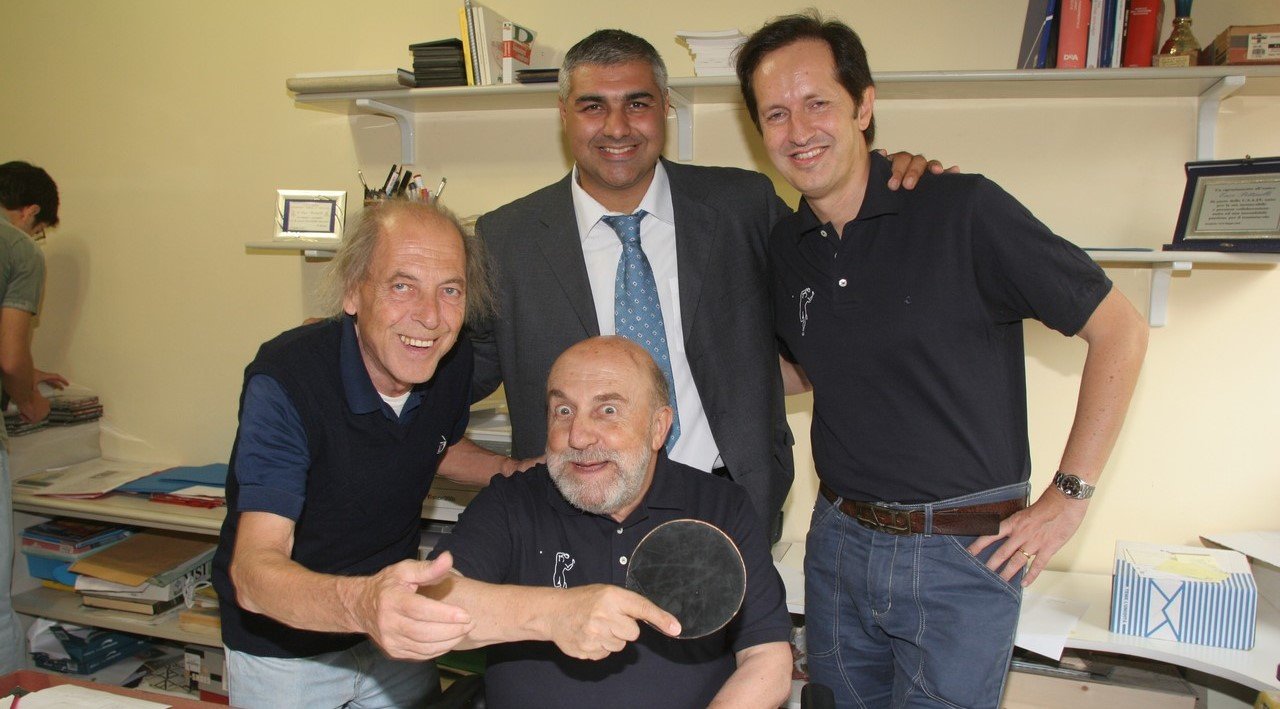 Pettinelli was going to be the national trainer of Italy and of the republic of San Marino for several times, and honorary member of the republic of Malta for the collaboration. The work and the passion for this sport, ping-pong, of the “grand master”, inspired the director Claudio Colombo who realized a short film, Shot, dedicated to him. Amongst the actors were Enrico Beruschi who mostly interpreted the part of Enzo Pettinelli.
Pettinelli was going to be the national trainer of Italy and of the republic of San Marino for several times, and honorary member of the republic of Malta for the collaboration. The work and the passion for this sport, ping-pong, of the “grand master”, inspired the director Claudio Colombo who realized a short film, Shot, dedicated to him. Amongst the actors were Enrico Beruschi who mostly interpreted the part of Enzo Pettinelli.